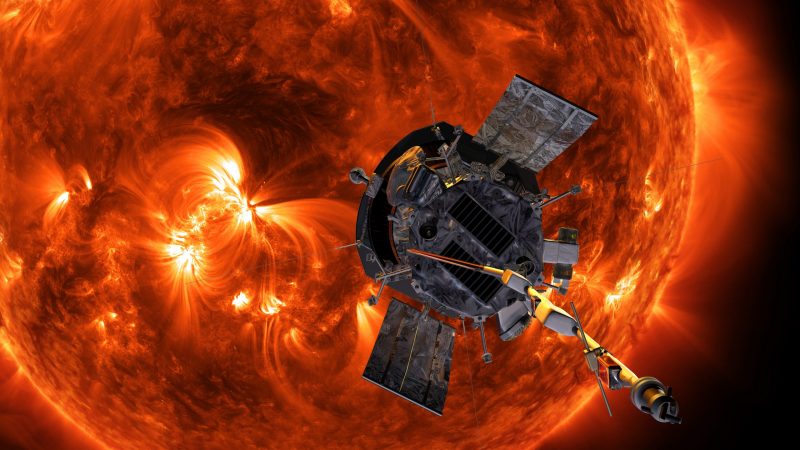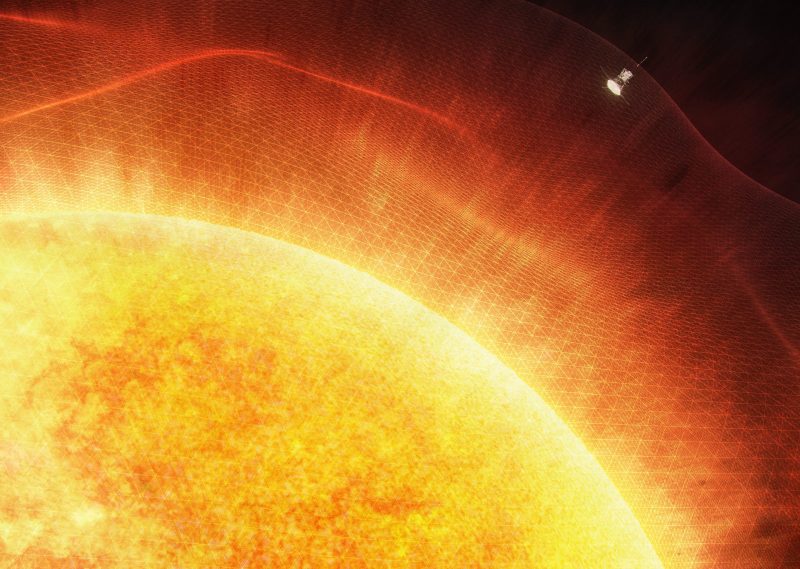
Launched in 2018, NASA’s Parker Solar Probe has been studying the sun from up close for several years. And on June 7, 2023, the University of California, Berkeley, said that Parker Solar Probe has now peered into a coronal hole on the sun, thereby witnessing the source of the solar wind. The press release explained:
It’s like seeing jets of water emanating from a showerhead through the blast of water hitting you in the face.
Stuart D. Bale of the University of California, Berkeley, and James Drake of the University of Maryland-College Park led the team that was able to detect the fine structure of the solar wind with Parker Solar Probe. The team will publish its peer-reviewed results this week in the journal Nature.
Parker Solar Probe sees source of solar wind
The team said that Parker Solar Probe has detected streams of high-energy particles that match the supergranulation flows within coronal holes. What does this mean? Well, first, coronal holes are dark openings in the sun’s magnetic field. In these holes, streams of high-speed solar wind rush out and away from the sun. Supergranulation is a word for the massive, bubbling convection cells on the sun. And solar material flows from these holes. So the new discovery suggests that the “fast” solar wind originates from coronal holes.
During years when the sun is active, such as now, coronal holes move from the poles and can appear all over the solar surface. When some of the fast solar wind coming from these holes takes aim at Earth, we can experience auroras. And, on the negative side, we can also experience satellite and electrical-grid disruptions. Drake said:
Winds carry lots of information from the sun to Earth, so understanding the mechanism behind the sun’s wind is important for practical reasons on Earth. That’s going to affect our ability to understand how the sun releases energy and drives geomagnetic storms, which are a threat to our communication networks.
Coronal holes are like showerheads
The easiest analogy with the sun and solar particles is to compare them to flowing water. Bale described the surface of the sun in terms of a pot of boiling water. He said:
The photosphere is covered by convection cells, like in a boiling pot of water, and the larger scale convection flow is called supergranulation. Where these supergranulation cells meet and go downward, they drag the magnetic field in their path into this downward kind of funnel. The magnetic field becomes very intensified there because it’s just jammed. It’s kind of a scoop of magnetic field going down into a drain. And the spatial separation of those little drains, those funnels, is what we’re seeing now with solar probe data.
The source of fast solar wind
Parker Solar Probe has provided insight to a question that puzzled astronomers. What is the source of the high-energy particles that can be 10 to 100 times faster than the average solar wind? With the new data, they’ve concluded that the source must be a process called magnetic reconnection. In this process, a magnetic field passes over a jet where an opposite magnetic field is streaming into space. When this happens, the fields can break and reconnect, flinging charged particles out of the sun.
Bale explained:
The big conclusion is that it’s magnetic reconnection within these funnel structures that’s providing the energy source of the fast solar wind. It doesn’t just come from everywhere in a coronal hole, it’s substructured within coronal holes to these supergranulation cells. It comes from these little bundles of magnetic energy that are associated with the convection flows. Our results, we think, are strong evidence that it’s reconnection that’s doing that.
Up close to the sun
Parker Solar Probe was able to make this discovery because of how near it can fly to the sun. In order to get a good look at the solar wind, it had to be within about 13 million miles (25 or 30 solar radii) of the sun’s surface. Bale said:
Once you get below that altitude, 25 or 30 solar radii or so, there’s a lot less evolution of the solar wind, and it’s more structured. You see more of the imprints of what was on the sun.
In 2021, the Parker Solar Probe became the first spacecraft to touch the sun. It flew through the wispy corona at a distance of 5.2 million miles (2 solar radii) from the surface of the sun. Parker Solar Probe flew through jets of material that the team traced back to supergranulation cells. They found that the high-energy particles – tens to hundreds of kiloelectron volts (keV) – in these jets must have gotten a boost through magnetic reconnection.
In addition, these jets create Alfvén waves. These waves are an undulation in the magnetic field.
Bale explained that some puzzles remain:
Our interpretation is that these jets of reconnection outflow excite Alfvén waves as they propagate out. That’s an observation that’s well known from Earth’s magnetotail, as well, where you have similar kind of processes. I don’t understand how wave damping can produce these hot particles up to hundreds of keV, whereas it comes naturally out of the reconnection process. And we see it in our simulations, too.

Parker Solar Probe and an active sun
When Parker Solar Probe next gets within 4 million miles (8.8 solar radii) of the sun, the team hopes to confirm its findings. However, as the sun is entering the most active part of its cycle, the chaos of activity on the sun may obscure the scientists’ view. Bale said:
There was some consternation at the beginning of the solar probe mission that we’re going to launch this thing right into the quietest, most dull part of the solar cycle. But I think without that, we would never have understood this. It would have been just too messy. I think we’re lucky that we launched it in the solar minimum.
Bottom line: The Parker Solar Probe has looked into a coronal hole, helping to identify the source of the fast solar wind. The scientists said magnetic reconnection of the solar field lines flings these high-energy particles into space.











